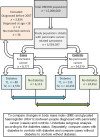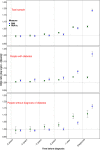BMI and HbA1c are metabolic markers for pancreatic cancer: Matched case-control study using a UK primary care database
- PMID: 36197912
- PMCID: PMC9534412
- DOI: 10.1371/journal.pone.0275369
BMI and HbA1c are metabolic markers for pancreatic cancer: Matched case-control study using a UK primary care database
Abstract
Background: Weight loss, hyperglycaemia and diabetes are known features of pancreatic cancer. We quantified the timing and the amount of changes in body mass index (BMI) and glycated haemoglobin (HbA1c), and their association with pancreatic cancer from five years before diagnosis.
Methods: A matched case-control study was undertaken within 590 primary care practices in England, United Kingdom. 8,777 patients diagnosed with pancreatic cancer (cases) between 1st January 2007 and 31st August 2020 were matched to 34,979 controls by age, gender and diabetes. Longitudinal trends in BMI and HbA1c were visualised. Odds ratios adjusted for demographic and lifestyle factors (aOR) and 95% confidence intervals (CI) were calculated with conditional logistic regression. Subgroup analyses were undertaken according to the diabetes status.
Results: Changes in BMI and HbA1c observed for cases on longitudinal plots started one and two years (respectively) before diagnosis. In the year before diagnosis, a 1 kg/m2 decrease in BMI between cases and controls was associated with aOR for pancreatic cancer of 1.05 (95% CI 1.05 to 1.06), and a 1 mmol/mol increase in HbA1c was associated with aOR of 1.06 (1.06 to 1.07). ORs remained statistically significant (p < 0.001) for 2 years before pancreatic cancer diagnosis for BMI and 3 years for HbA1c. Subgroup analysis revealed that the decrease in BMI was associated with a higher pancreatic cancer risk for people with diabetes than for people without (aORs 1.08, 1.06 to 1.09 versus 1.04, 1.03 to 1.05), but the increase in HbA1c was associated with a higher risk for people without diabetes than for people with diabetes (aORs 1.09, 1.07 to 1.11 versus 1.04, 1.03 to 1.04).
Conclusions: The statistically significant changes in weight and glycaemic control started three years before pancreatic cancer diagnosis but varied according to the diabetes status. The information from this study could be used to detect pancreatic cancer earlier than is currently achieved. However, regular BMI and HbA1c measurements are required to facilitate future research and implementation in clinical practice.
Conflict of interest statement
The authors have declared that no competing interests exist.
Figures



References
-
- Sung H., et al.., Global Cancer Statistics 2020: GLOBOCAN Estimates of Incidence and Mortality Worldwide for 36 Cancers in 185 Countries. CA: A Cancer Journal for Clinicians, 2021. 71(3): p. 209–249. - PubMed
-
- CancerResearchUK. Cancer survival statistics. Health professional/ cancer statistics 2021. [cited 2021 21/10/2021]; Available from: https://www.cancerresearchuk.org/health-professional/cancer-statistics/s....
Publication types
MeSH terms
Substances
LinkOut - more resources
Full Text Sources
Medical

